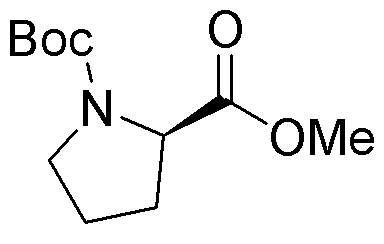Boc-D-proline methyl ester is widely utilized in research focused on:
- Peptide Synthesis: This compound serves as a key building block in the synthesis of peptides, particularly in the development of pharmaceuticals. Its stable structure allows for efficient coupling reactions.
- Drug Development: In medicinal chemistry, it is used to create proline derivatives that can enhance the bioactivity of drug candidates, making it valuable in the pharmaceutical industry.
- Biochemical Research: Researchers use Boc-D-proline methyl ester in studies related to protein folding and stability, helping to understand the role of proline in biological systems.
- Material Science: This compound can be incorporated into polymers to improve their mechanical properties, making it useful in the development of advanced materials.
- Food Industry: It can be explored as a flavoring agent or a food additive, contributing to the development of new food products with enhanced taste profiles.
General Information
Properties
Safety and Regulations
Applications
Boc-D-proline methyl ester is widely utilized in research focused on:
- Peptide Synthesis: This compound serves as a key building block in the synthesis of peptides, particularly in the development of pharmaceuticals. Its stable structure allows for efficient coupling reactions.
- Drug Development: In medicinal chemistry, it is used to create proline derivatives that can enhance the bioactivity of drug candidates, making it valuable in the pharmaceutical industry.
- Biochemical Research: Researchers use Boc-D-proline methyl ester in studies related to protein folding and stability, helping to understand the role of proline in biological systems.
- Material Science: This compound can be incorporated into polymers to improve their mechanical properties, making it useful in the development of advanced materials.
- Food Industry: It can be explored as a flavoring agent or a food additive, contributing to the development of new food products with enhanced taste profiles.
Documents
Safety Data Sheets (SDS)
The SDS provides comprehensive safety information on handling, storage, and disposal of the product.
Product Specification (PS)
The PS provides a comprehensive breakdown of the product’s properties, including chemical composition, physical state, purity, and storage requirements. It also details acceptable quality ranges and the product's intended applications.
Certificates of Analysis (COA)
Search for Certificates of Analysis (COA) by entering the products Lot Number. Lot and Batch Numbers can be found on a product’s label following the words ‘Lot’ or ‘Batch’.
*Catalog Number
*Lot Number
Certificates Of Origin (COO)
This COO confirms the country where the product was manufactured, and also details the materials and components used in it and whether it is derived from natural, synthetic, or other specific sources. This certificate may be required for customs, trade, and regulatory compliance.
*Catalog Number
*Lot Number
Safety Data Sheets (SDS)
The SDS provides comprehensive safety information on handling, storage, and disposal of the product.
DownloadProduct Specification (PS)
The PS provides a comprehensive breakdown of the product’s properties, including chemical composition, physical state, purity, and storage requirements. It also details acceptable quality ranges and the product's intended applications.
DownloadCertificates of Analysis (COA)
Search for Certificates of Analysis (COA) by entering the products Lot Number. Lot and Batch Numbers can be found on a product’s label following the words ‘Lot’ or ‘Batch’.
*Catalog Number
*Lot Number
Certificates Of Origin (COO)
This COO confirms the country where the product was manufactured, and also details the materials and components used in it and whether it is derived from natural, synthetic, or other specific sources. This certificate may be required for customs, trade, and regulatory compliance.


